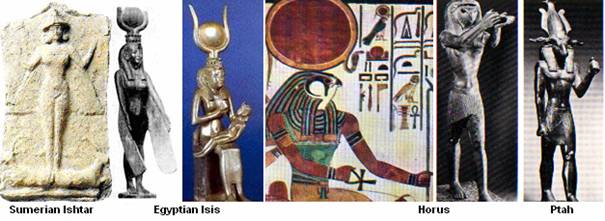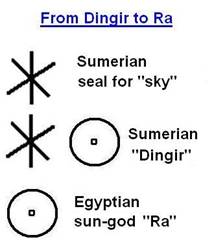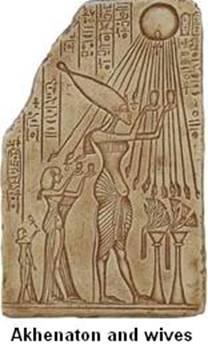|
When the
ancient Egyptian religion is considered, one can see that the
entire belief system revolved around the cult of
sun-worshipping. Several different names were given to the
early sun-gods of ancient Egypt. Horned animals as well as
birds were physical representations of these deities on earth.
Below left we see a mythical bull-bird carved on the wall of a
temple. The central image is the well known Apis bull or ox.
The disc with a cobra in the middle is a typical
representation of the sun. On the right a row of ram-lions are
protecting different pharaohs.

The
symbolism in mixing animals is also found in the Sumerian
culture and can be traced back to the Central Asiatic root
culture. We can follow this symbolism throughout the ages as
consecutive historical periods. In ancient Egypt this
symbolism is very clear and has been transmitted in the form
of statues and wall paintings. Below we see some such
examples.

The
female Sumerian deity Ishtar is stepping on two mountain
goats. She has wings and a headdress with horns similar to the
one Anu wears (see Chapter 19,
The Bull and the Letter B).
The same symbolism is found in the Egyptian goddess Isis who
has wings, bull horns and the solar disc above her head. The
wall painting is depicting Horus holding the Ankh in his right
hand and the solar disc encircled by the cobra named Khut
stands above his head. On the right we see the half man half
goat deity named Ptah.
In Chapter
6, Universal Symbols,
the connection of the Ankh to the solar disc and to the + sign
was discussed. The hawk-headed Horus as well as Ra, Amun and
Atun are all different names and representations of the same
sun-god. Lewis Spence says
(1):
Ra, the great god of the sun, appears to have occupied a
prominent position in the Egyptian pantheon at a very early
period. The Egyptians of later days appear to have thought
that the name was in some way associated with creation.
Sun-worship in Egypt was very ancient, and it is probable that
a number of sun-cults became fused in that of Ra.
Although
almost all of the Egyptian deities had a half human half
animal form, only Ra
was an exception and was represented by the solar disc –a
circle with a point in the center-. This representation has
its roots in the early ON symbol of the Proto-language (see
Chapter 7, The Minoan culture).
I am of the opinion that Ra was imported from the Sumerian
culture and his name came from
Dingir, the main
Sumerian deity.
In the
Sumerian pictographic writing system the sky was represented
by a six-pointed star and the sun by a circle with a dot at
the center. When the Sumerians wanted to write “dingir” they
drew the two symbols next to each other, as shown below.
Dingir was the sun-god residing in the sky. This way of
writing Dingir was logical because the Sumerian language was
agglutinative and words could be created by adding suffixes.

In fact
Dingir comes from
the Central Asiatic Ting-ri
or Tengri, still
existing as Tanrý
in Turkish. Words similar to Tengri (meaning God) can be found
in many remote parts of the world. Examples are:
Tengeri
for the Central Asiatic Buryat Turks,
Týngýr for the Tartars
of Crimea, Tanka
for the North-American Indians,
Tangaroa
for the Pacific islanders,
Tian for the Chinese
and Tin for the
Etruscans. The ancient Egyptians adopted the solar disc
standing for the suffix –ri
as the name of the sun-god and called it
Ra, as shown below.
Actually,
not only Ra
but also
Horus
is known to be related to the sun. Hor-us (Hor is) was adopted
as the sun-god by the Romans during the Ptolemaic era. In time
Hor became part of
the Latin language and found its place in words such as
“horizon”, “horizontal”, “horoscope” and even “hour” in
English and “heure” in French.
Another
deity related to the sun is
Ptah. He personified the rising sun, or, rather the
early morning sun, immediately after it has risen
(2).
Aton,
one of the most prominent sun-gods of Ancient Egypt came in
time to signify both the sun-god and the actual solar disk. It
was during the reign of Akhanaton “Ak-Han-Ata-On” which lasted
only 17 years -from 1379 BC to 1362 BC- that Aton “Ata-on”
became the main deity of the entire Egyptian kingdom. Aton
was regarded as the creator of the earth, self-existent and
measurer of the lives of men.
Below we see
Ak-han-ata-on making offerings to the sun with his wives
Nefertiti and Kiya standing behind
(3).
They are receiving ankhs form the sun, the symbol of power and
longevity. During his reign artists routinely portrayed the
pharaoh in informal situations –being affectionate with
Nefertiti or playing with his children. Akhanaton unleashed a
creative furor that gave rise to perhaps the finest era of
Egyptian art (4).
He even founded a new city Akhataton near the present city of
Amarna.
After the
death of Akhanaton, his son Tutankhamon “Tutan-Okh-Ama-On”
(the one protecting Amon) assumed power. He was under the
influence of the Amon priests and reinstated Amon as the main
god of Egypt. Within two years the religious capital was moved
from Akhataton to Thebes. Soon the temples were demolished and
Akhetaton was turned into rubbles. The ancient religion of the
Amon priests came back to power, even stronger than before.
 |